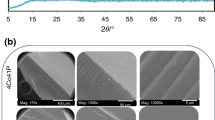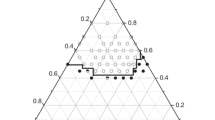Abstract
Calcium phosphate glasses (CPG) with varying concentrations of uranium were synthesized by melt quench method. Maximum solid solubility of uranium in CPG was determined by using X-ray diffraction technique. Heat capacity (Cp) of the pristine CPG and uranium-loaded CPG was measured by drop calorimetry and differential scanning calorimetry. Heat capacity measured by drop calorimetry of pristine glass (CPG) was found to be 0.74 Jg−1 K−1at 298 K; on loading 0.8 mol% of uranium oxide, Cp value decreased to 0.58 Jg−1 K−1 and further higher loading of 2 mol% uranium oxide shows further reduction of Cp to 0.55 Jg−1 K−1. This decrease in Cp may be due to the weakening of glass network structure as uranium loading increases into glass matrix. Ratio of the number of bridging to non-bridging oxygen is decreasing gradually on increasing the amount of uranium in glass. The same has been observed for the DSC measurement as well; where the pristine glass (CPG) has higher heat capacity values compared to CPG-0.8 and CPG-2. In case of DSC, CPG-0.8 shows slightly lower values of heat capacity compared to CPG-2, this may be due to the structural changes by which the bonding between the atoms may slightly increase while going to higher amount of waste constituents. Glass transition temperature (Tg) of the glass matrices has been measured and it shows gradual increase on loading uranium in glass matrix from 0.8 to 6 mol%.







Similar content being viewed by others
References
Ojovan MI, Lee WE. An Introduction to Nuclear Waste Immobilisation. Amsterdam: Elsevier Science Publishers BV; 2005.
Boccaccini AR, Bernardo E, Blain L, Boccaccini DN. Borosilicate and lead glass matrix composites containing pyrochlore phases for nuclear waste encapsulation. J Nucl Mater. 2004;327:148–58.
Sobolev IA, Dmitriev SA, Lifanov FA, Kobelev AP, Stefanovsky SV, Ojovan MI. Vitrification processes for low, intermediate radioactive and mixed wastes. Glass Technol. 2005;46:28–35.
Bates JK, Ellison AJG, Emery JW, Hoh JC. Glass as a waste form for the immobilisation of plutonium. Mater Res Soc Symp Proc. 1996;412:57–64.
Ojovan MI, Lee WE. Self sustaining vitrification for immobilisation of radioactive and toxic waste. Glass Technol. 2003;44(6):218–24.
Lambert SL, Kim DS. Pacific Northwest National Laboratory Report. PNNL #WHC-SP-1143; 1994
Perez JM Jr., Bickford DF, Day DE, Kim DS, Lambert SL, MarraSL, PeelerDK, Strachan DM, Triplett MB, Vienna JD, WittmanRS. Pacific Northwest National Laboratory Report; PNNL-13582; 2001.
Kim CW, Ray CS, Zhu D, Day DE, Gombert D, Aloy A, Moguš-Milanković A, Karabulut M. Chemically durable iron phosphate glasses for vitrifying sodium bearing waste (SBW) using conventional and cold crucible induction melting (CCIM) techniques. J Nuclear Mater. 2003;322(2–3):152–64. https://doi.org/10.1016/S0022-3115(03)00325-8.
Reidmeyer MR, Day DE. Phosphorus oxynitride glasses. J Non-Cryst Solids. 1995;181:201–14.
Reidmeyer MR, Day DE. Structural model for nitrogen incorporation in phosphate glasses. J Mater Res. 1991;6:1757–62.
Reidmeyer MR, Rajaram M, Day DE. Preparation of phosphorous oxynitride glasses. J Non-Cryst Solids. 1986;85(1–2):186–204.
Day DE. Structural role of nitrogen in phosphate glasses. J Non-Cryst Solids. 1989;112(5):7–14.
Peng YB, Day DE. High thermal expansion phosphate glasses. Glass Technol. 1991;32:166–73.
Sales BC, Boatner LA. Lead-iron phosphate glass: a stable storage medium for high-level nuclear waste. Science. 1984;226(4670):45–8.
Praveena N, Maji BK, Jena H. Effect of uranium oxide loading on the enthalpy increment (dH) and heat capacity (Cp) values of modified borosilicate glass for radwaste immobilization. J Therm Anal Calorim. 2019;136(2):697–701.
Grimvall G. Thermophysical properties of materials. North-Holland: B. V. Elsevier Science; 1999.
Maji BK, Jena H, Krishnaiah MV. Determination of Cp from enthalpy increment on pristine glasses and its glass-bonded ceramic composites loaded with 10 mass% simulated pyrochemical waste by drop calorimetry. J Therm Anal Calorim. 2017;129:249–59.
Krishnaiah MV. Study of the thermophysical properties of some materials of interest in nuclear technology. Ph.D. Thesis, University of Madras; 2000. pp. 96–104.
Chatwal GR, Anand SK. Thermal methods. Instrumental methods of chemical analysis. Fifth Edition: Himalaya Publication House; 2002. pp. 2.749–2.751.
Willard HH, Merritt LL, Dean JA, Settle FA. Thermal analysis. Instrumental methods of analysis. Seventh edition: CBS publishers; 2012. p. 761.
Skoog DA, Holler FJ, Crouch SR. Thermal methods. Instrumental analysis. India edition: Cengage Learning; 2011. pp. 982–984
Liu Z, Xu J, Wang Y, Jian Z, Liu J. Specific heat measurement of Ge7.4Se92.6 glass. J Therm Anal Calorim. 2018;131:3133–8. https://doi.org/10.1007/s10973-017-6777-3.
Krishnan R, Jena H, Kutty KVG, et al. Heat capacity and thermal expansion coefficient of rare earth uranates RE6UO12 (RE = Nd, Gd and Eu). J Therm Anal Calorim. 2010;101:371–7. https://doi.org/10.1007/s10973-009-0618-y.
Auxilia LS, Jena H, Senapati A, Sudha R. Studies on rhenium (Re) solubility and heat capacity measurements onCa10−xRex (PO4)6 (OH) 2±δ, x = 0 to 0.7 for radwaste immobilization. Thermochim Acta. 2021;696:178824.
Maji BK, Jena H, Asuvathraman R. Electrical conductivity and glass transition temperature (Tg) measurements on some selected glasses used for nuclear waste immobilization. J Non-Cryst Solids. 2016;434:102–7.
Author information
Authors and Affiliations
Corresponding author
Additional information
Publisher's Note
Springer Nature remains neutral with regard to jurisdictional claims in published maps and institutional affiliations.
Rights and permissions
Springer Nature or its licensor (e.g. a society or other partner) holds exclusive rights to this article under a publishing agreement with the author(s) or other rightsholder(s); author self-archiving of the accepted manuscript version of this article is solely governed by the terms of such publishing agreement and applicable law.
About this article
Cite this article
Jena, H., Praveena, N. & Senapati, A. Solid solubility of uranium in Ca-phosphate glass and its impact on heat capacity and Tg of the glass matrix. J Therm Anal Calorim 148, 3213–3219 (2023). https://doi.org/10.1007/s10973-023-11947-2
Received:
Accepted:
Published:
Issue Date:
DOI: https://doi.org/10.1007/s10973-023-11947-2




